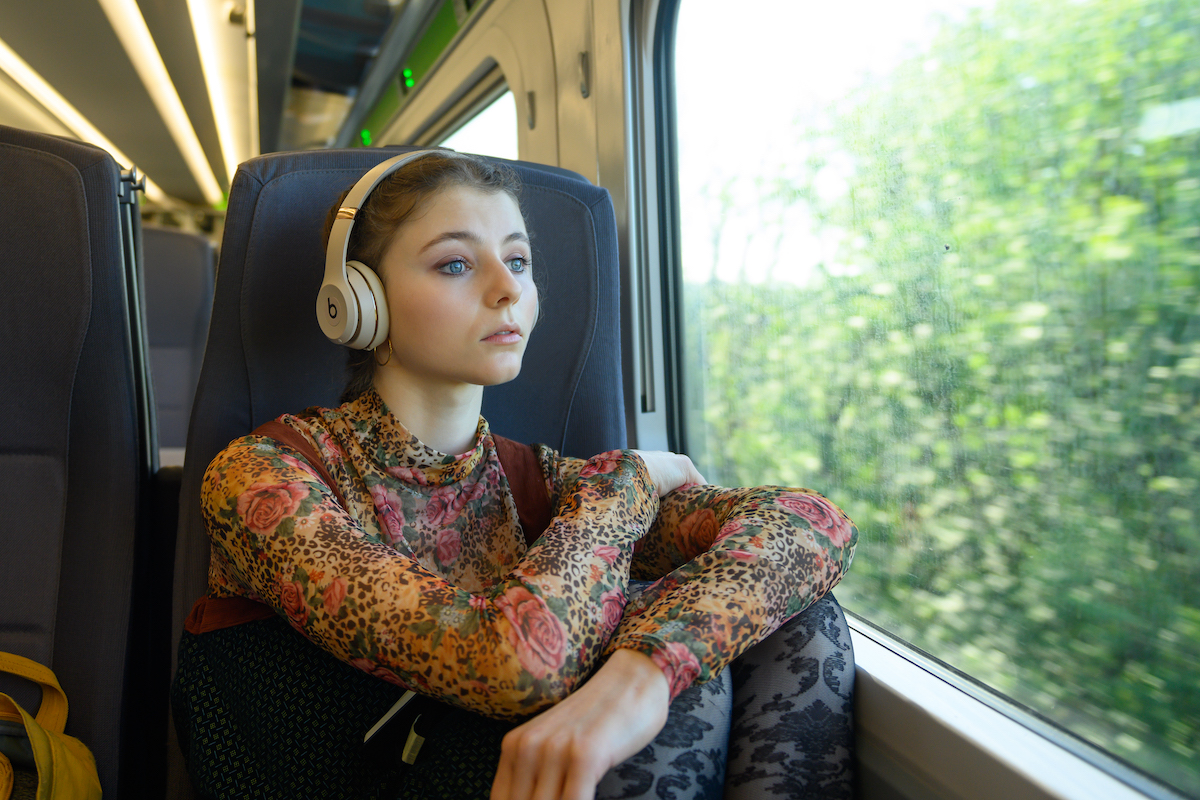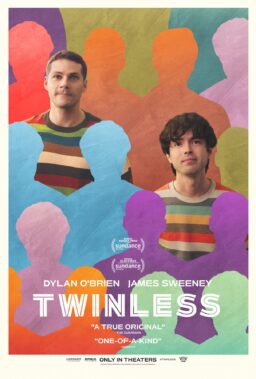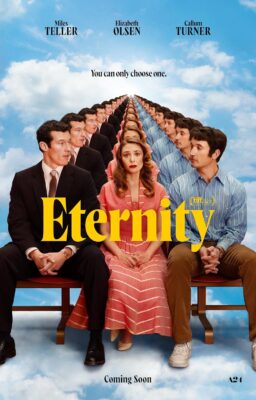Many performers have spent their childhood dreaming of one day becoming an actor, but that was not at all the case with Thomasin McKenzie. Part of the reason may have been the fact that she grew up with a mother, Miranda Harcourt, who believes that virtually everything is about acting. “That can be a little tiring and relentless for my family,” Miranda admitted to me during my 2018 interview with her, in which she discussed her work as a veteran acting coach whose clients have included Nicole Kidman and Melanie Lynskey. “Early on, Thomasin was like, ‘Oh my god, acting—get away from me!’ That created a very strong wellspring for her to discover her talent because she didn’t want to do it. She didn’t want to be famous and she wasn’t aiming towards acting to achieve anything. She was running away from it, and finding other things that interested her, like psychology, visual arts, writing—she’s a very good writer—and she was searching out other elements in her identity that she could explore and be rewarded by.”
It wasn’t until Miranda began coaching a few actors via Skype for the harrowing titular role in Robert Sarkies’ 2014 fact-based drama, “Consent: The Louise Nicholas Story,” that Thomasin first expressed the desire to act. The film chronicles the life of a woman who was raped by policemen from the age of 13 up until her young adulthood, and Thomasin, who was the same age as the teenage version of Louise, suddenly mentioned to her mother that she would like to audition. “But you hate acting,” Miranda replied, prompting Thomasin to explain, “It sounds like a really great story to tell.” Realizing that their daughter was serious, Miranda and her husband, filmmaker Stuart McKenzie, decided to show Thomasin a film that showcased an aesthetic of acting that they deeply believed in, Debra Granik’s Oscar-nominated drama from 2010, “Winter’s Bone.” How fitting that Thomasin’s breakout role later proved to be in Granik’s equally masterful 2018 drama, “Leave No Trace,” in which she starred opposite Ben Foster as a shrewd and sensitive girl entering the modern world after living with her hermetic father in the woods.
When I first interviewed Thomasin at the Karlovy International Film Festival that year, she spoke of how making “Consent” left an indelible impact on her. “That experience made me realize how, through acting, I have an opportunity to make a difference,” she said. “I realized that acting was what I wanted to do, not because of the fame side of it, but because of the reward at the end of knowing that you put a really important story out into the world.” The same could be said of her next major role in Taika Waititi’s seriocomic anti-hate crowd pleaser, “Jojo Rabbit,” which Thomasin was filming at the time in Prague. She played a Jewish girl hiding in the attic of a pint-sized Hitler Youth member (Roman Griffin Davis), and it is the bond that forms between their characters that emerges as the heart of the picture, which resulted in Waititi becoming the first indigenous person to receive the Best Adapted Screenplay Oscar. Upon the film’s premiere a year later at the Chicago International Film Festival, Thomasin told me, “Especially given the current political climate we’re living in right now, it is a reminder to everyone about the atrocities of the past and a warning that we cannot let these things be repeated.”

Little did I know that when we spoke at CIFF, Thomasin had just finished filming her role as Eloise in Edgar Wright’s highly anticipated horror film, “Last Night in Soho,” which finally arrives in U.S. theaters today and turned out to be the first pandemic-era press screening I felt within my comfort level to attend. Apart from being an exhilarating work of pure cinema, Wright’s picture evokes the dark underbelly of David Lynch’s similarly surrealistic dreamscape in 2001’s “Mulholland Dr.”, another movie Stuart cites as one of his favorites. Both films potently portray the exploitation and power imbalances that have marred the performing arts industries from their earliest days, viewing the atrocities from a haunted and complex female perspective. I was reminded of Thomasin’s description of how Louise Nicholas struggled to live with what happened to her while being uncertain about what to do with it. Though the heaviness of these themes caused “Soho” to be an emotionally draining film to make at times for Thomasin, she says the experience was also a loving one that enabled her to grow close to Wright and his co-writer, “1917”’s Krysty Wilson-Cairns.
Not only is Thomasin’s performance as Eloise, a wide-eyed woman from Cornwall who enrolls at an elite London fashion school, her most astonishing since “Leave No Trace,” it also affirms how her screen persona carries unmistakable shades of Audrey Hepburn—in her gamine physique, her intricately nuanced artistry that serves as the emotional anchor of each picture it graces, and most especially, her innate goodness that she naturally radiates in every frame, causing viewers to instantly become invested in her character’s well-being. When I told Thomasin this during our brief chat at a virtual junket this week, she exuberantly thrust her fists up in the air while mouthing “YES!” before telling me, “I love everything about Audrey Hepburn. I grew up watching her in films like ‘Funny Face,’ ‘My Fair Lady’ and ‘Sabrina’ and I thought she was such a magical actress. She just had such light to her. She was so engaging that you could not help but watch her, and her style was amazing. I just really, really wish I could have worked with her, or at least could have met her.”
I also recently caught up via Zoom with Miranda and Stuart, who are eagerly awaiting seeing “Soho” for the first time when it opens next month near their home in New Zealand, where it will screen at the Embassy Theatre, the same venue where Peter Jackson’s “Lord of the Rings” and “Hobbit” films premiered (incidentally, both Thomasin and Miranda appeared in the final “Hobbit” film). “Thomasin’s best friend here in New Zealand, Kiki Miwa, has a mother who looks a lot like Audrey Hepburn,” said Miranda. “She’s married to a Japanese man, and when they lived in Japan together, Hepburn fans would see her and exclaim, ‘Audrey! Audrey!’ So this kind of mythic Audrey Hepburn vibe has always been around Thomasin from a very early age.” It was Kiki who took Thomasin to various classes at the New Zealand School of Dance in order to prepare her for the role of Eloise. Wright’s ingenious approach to choreographed movement is perhaps best encapsulated by the opening credits of his 2017 film, “Baby Driver,” which required Ansel Elgort to impeccably hit every mark as he walked to and from a coffee shop, causing props, gestures and lines to synchronize effortlessly with Bob & Earl’s “Harlem Shuffle” on the soundtrack. “Soho” opens with an equally marvelous opening credits sequence where Thomasin dances around her bedroom, at one point striking a Hepburn-esque pose in front of a “Breakfast at Tiffany’s” poster.

When I asked Thomasin whether the entire film felt like a dance to her, she laughed, “Definitely! So much of the film was about movement, rhythm and keeping with the beat. I’m not a dancer, so it was a big challenge for me. I’ve played piano all my life, though not so much recently—I need to get back onto it. Luckily, that gave me a good bearing for staying to the beat, with the metronome tics and everything. It was all about loosening up and enjoying movement, and Anya Taylor-Joy really helped me a lot with that, actually, because she is such a beautiful dancer. So I just leaned on her and mimicked her a little bit. I tried to kind of emulate Anya, like Ellie was doing.” Taylor-Joy undergoes an equally stunning transformation as Sandie, a blonde nightclub singer whose body McKenzie inhabits during her strangely vivid fever dreams set in ’60s-era Soho (Wright inventively conveys this through the use of mirrors). Sequences such as the dance where Eloise and Sandie continuously swap spots with Jack (Matt Smith) undoubtedly demanded a tremendous amount of precision, but as Miranda noted, “Thomasin is a smart kid. She understands that it’s not enough to just do it. You’ve got to do it well enough that you can achieve joy and effortlessness.”
Thomasin’s efforts to lay down the experiential seeds of her character led her to the School of Design at Massey University in Wellington where she attended lectures, did numerous sewing projects and learned how to hand-stitch, all the while working with the college’s Program Leader for Fashion, Sue Prescott. These activities go along with Thomasin’s usual process in preparing for a role, which includes changing her own personal interests to reflect those of her character, collecting objects that hold meaning for her and keeping a journal in the voice of her character. In the midst of her intensive shooting schedule, she also took full advantage of being on location in London by immersing herself in the city’s culture and galleries, some of which coincidentally had Mary Quant exhibitions brimming with ’60s fashion. “When we first got to Soho, Thomasin and I actually stayed for three weeks in the same building where Thomas De Quincy wrote Confessions of an English Opium-Eater, so the history of the area was very much infused in our surroundings,” recalled Stuart. “We wandered around Soho and caught a production of ‘The Curious Incident of the Dog in the Nighttime.’ This was pre-COVID, so we would go out at night when the place was just teeming with people. The bar across the road, known as the Pillars of Hercules, was where a lot of the quintessential British writers, such as Ian McEwan, used to congregate, so we’d go there and get a drink. Edgar and Krysty’s story looks at how the environment haunts those who live there, and we really felt that when we were living in Soho.”
Miranda likened this to the experience she had on the set of Jane Campion’s rapturous 2009 gem, “Bright Star,” in which she coached young actress Edie Martin. “Jane would gather everyone in the small room above a hotel where John Keats actually did a lot of his writing, and she had Andrew Motion, who was Keats’ biographer, read Keats’ poetry to us in this room,” said Miranda. “This required us to take quite a trip out of where we were staying to go there, but Jane felt it was very important that the essence of the location would infuse into the nature of the performances.” Another spirit Thomasin held with her throughout filming was that of her grandmother, Kate Harcourt, the revered star of stage and screen with whom she shares a deep connection, a bond that is mirrored by Eloise’s relationship with her grandma. Now 94, Kate gifted Thomasin with an embroidered pillow displaying both of their names, just before her granddaughter flew to LA for this week’s “Soho” premiere. “They shared a very moving embrace, I guess because Kate is wondering when or if she’ll get to see Thomasin again,” said Stuart, his voice choked with emotion. “But what Kate said to her was, ‘Go out there, have fun, work hard, and I’m very proud of you.’”

“Soho” also boasts a wonderful performance from screen legend Diana Rigg as Ms. Collins, the crotchety landlady at Eloise’s apartment. The towering actress died shortly after production wrapped, and her work here is as fitting a final bow as Christopher Plummer’s droll turn as the celebrated patriarch in Rian Johnson’s “Knives Out.” Rigg was also impressed with Thomasin’s Cornwall accent, which she developed while spending time with Stuart in the barren industrial town of Redruth where Eloise is from. During their visit, they saw the inferior reboot of “Hellboy” at a local movie house and found that they were the only people in the theater. Thomasin decided to stay in her Cornwall accent throughout the production, both on and off the set, not to mention at a dinner with Jane Campion and Benedict Cumberbatch prior to collaborating with them in “The Power of the Dog.” Therefore, Rigg had no idea Thomasin was from New Zealand until she met Miranda, whose Kiwi accent prompted the actress to exclaim, “What’s going on?!” Then, as recounted by Miranda, she looked at Thomasin and went, “Good on you.”
Yet no matter how big Thomasin’s stardom becomes on an international scale, what continuously grounds her perspective and makes her work so captivating is her uncommon compassion for people and their stories that she tirelessly endeavors to share with the world. “So much happens in ‘Last Night in Soho’ that it was hard for me to take in the big picture until I saw the finished product a couple of months ago in the U.K.,” Thomasin told me. “That’s when I realized quite how feminist it is, and how strong that theme is throughout the film. It has a message that I believe is really important for us to continue sharing. Also, Ellie is obviously having a really tough time in the film, and I can relate to that as many people do. I have experienced anxiety, and Ellie’s story reminds us to be kind to ourselves, to be okay with taking a step back and to be okay with not being okay.”












